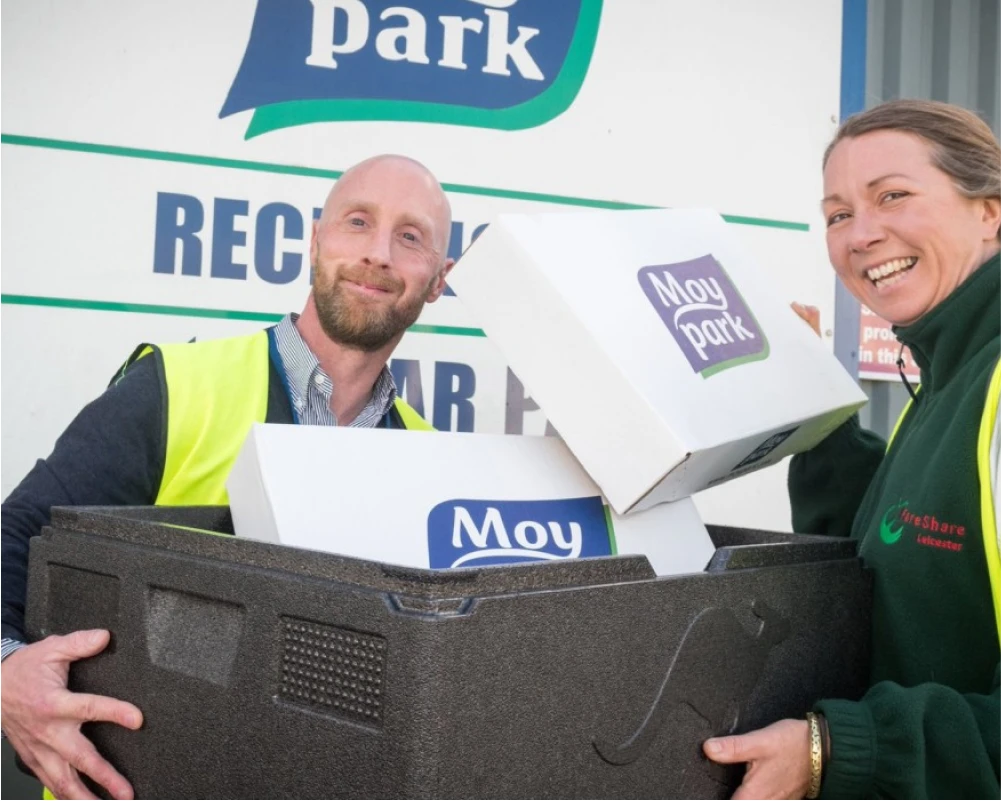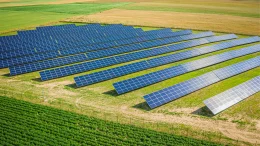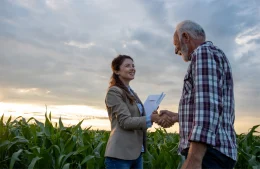
Waste & Recycling Practices
We have procedures in place to collect, transport, and dispose of waste in accordance with regional laws and regulations. Pilgrim’s teams have also set goals in each production facility to decrease the amount of packaging used in finished products, including waste generated and sent to landfill.
With an adherence to our product safety standards mandated by the Institute of Scrap Recycling Industries, we continue to look for opportunities to enhance our recycling practices — including exploring alternative materials with greater recyclability and technologies that help reduce packaging.
With a packaging strategy built around a packaging impact reduction program, Pilgrim’s Europe fundamentality focuses on reducing and minimizing packaging, designing for recyclability, and increasing recycled content. Through challenging innate packaging processes, Pilgrim’s Europe aims to implement more innovative and less impactful pack formats. Pilgrim’s Europe actively works to minimize packaging through size and weight reduction, specifying recyclable mono materials and adopting materials with post-consumer recyclate.
In 2023, Pilgrim's Mexico swapped its traditionally used Styrofoam trays for PET — which is one of the most recyclable materials that can be recycled indefinitely without losing quality – across its Just Bare product line. Pilgrim’s Mexico is currently working on the development of recyclable packaging materials and packaging that reduces material use.
Waste & Recycling Practices
We have procedures in place to collect, transport, and dispose of waste in accordance with regional laws and regulations. Pilgrim’s teams have also set goals in each production facility to decrease the amount of packaging used in finished products, including waste generated and sent to landfill.
With an adherence to our product safety standards mandated by the Institute of Scrap Recycling Industries, we continue to look for opportunities to enhance our recycling practices — including exploring alternative materials with greater recyclability and technologies that help reduce packaging.
With a packaging strategy built around a packaging impact reduction program, Pilgrim’s Europe fundamentality focuses on reducing and minimizing packaging, designing for recyclability, and increasing recycled content. Through challenging innate packaging processes, Pilgrim’s Europe aims to implement more innovative and less impactful pack formats. Pilgrim’s Europe actively works to minimize packaging through size and weight reduction, specifying recyclable mono materials and adopting materials with post-consumer recyclate.
In 2023, Pilgrim's Mexico swapped its traditionally used Styrofoam trays for PET — which is one of the most recyclable materials that can be recycled indefinitely without losing quality – across its Just Bare product line. Pilgrim’s Mexico is currently working on the development of recyclable packaging materials and packaging that reduces material use.
Waste & Recycling Practices
We have procedures in place to collect, transport, and dispose of waste in accordance with regional laws and regulations. Pilgrim’s teams have also set goals in each production facility to decrease the amount of packaging used in finished products, including waste generated and sent to landfill.
With an adherence to our product safety standards mandated by the Institute of Scrap Recycling Industries, we continue to look for opportunities to enhance our recycling practices — including exploring alternative materials with greater recyclability and technologies that help reduce packaging.
With a packaging strategy built around a packaging impact reduction program, Pilgrim’s Europe fundamentality focuses on reducing and minimizing packaging, designing for recyclability, and increasing recycled content. Through challenging innate packaging processes, Pilgrim’s Europe aims to implement more innovative and less impactful pack formats. Pilgrim’s Europe actively works to minimize packaging through size and weight reduction, specifying recyclable mono materials and adopting materials with post-consumer recyclate.
In 2023, Pilgrim's Mexico swapped its traditionally used Styrofoam trays for PET — which is one of the most recyclable materials that can be recycled indefinitely without losing quality – across its Just Bare product line. Pilgrim’s Mexico is currently working on the development of recyclable packaging materials and packaging that reduces material use.
Circular Economy Approach
Across the Company and our operations, we are exploring strategic circular-economy concepts that will enable us to reduce, reuse, recover and recycle materials and energy within closed loop systems.
Circular Economy Approach
Across the Company and our operations, we are exploring strategic circular-economy concepts that will enable us to reduce, reuse, recover and recycle materials and energy within closed loop systems.
Circular Economy Approach
Across the Company and our operations, we are exploring strategic circular-economy concepts that will enable us to reduce, reuse, recover and recycle materials and energy within closed loop systems.
Tackling Food Waste
To ensure we are preventing food waste, we process byproducts to create saleable materials. In 2022, we committed to the USDA and EPA’s goal to reduce food loss and waste by 50% by 2030, and we remain committed to reaching that goal in our own operations.
Rendering — the process of repurposing byproducts that would otherwise go to waste — is an important but often overlooked component of food sustainability. According to the North American Renderers Association (NARA), the meat, bone, hide, and other scrap materials that many consumers consider inedible are reclaimed and recycled into more than 8.6 million metric tons of fat, oil, and protein each year via rendering. Responsibly diverting these materials from landfill and other disposal methods helps reduce food waste, decrease GHG emissions, and return clean water to natural waterways. In addition, many materials are responsibly repurposed into valuable new products such as sustainable fuels.
Tackling Food Waste
To ensure we are preventing food waste, we process byproducts to create saleable materials. In 2022, we committed to the USDA and EPA’s goal to reduce food loss and waste by 50% by 2030, and we remain committed to reaching that goal in our own operations.
Rendering — the process of repurposing byproducts that would otherwise go to waste — is an important but often overlooked component of food sustainability. According to the North American Renderers Association (NARA), the meat, bone, hide, and other scrap materials that many consumers consider inedible are reclaimed and recycled into more than 8.6 million metric tons of fat, oil, and protein each year via rendering. Responsibly diverting these materials from landfill and other disposal methods helps reduce food waste, decrease GHG emissions, and return clean water to natural waterways. In addition, many materials are responsibly repurposed into valuable new products such as sustainable fuels.
Tackling Food Waste
To ensure we are preventing food waste, we process byproducts to create saleable materials. In 2022, we committed to the USDA and EPA’s goal to reduce food loss and waste by 50% by 2030, and we remain committed to reaching that goal in our own operations.
Rendering — the process of repurposing byproducts that would otherwise go to waste — is an important but often overlooked component of food sustainability. According to the North American Renderers Association (NARA), the meat, bone, hide, and other scrap materials that many consumers consider inedible are reclaimed and recycled into more than 8.6 million metric tons of fat, oil, and protein each year via rendering. Responsibly diverting these materials from landfill and other disposal methods helps reduce food waste, decrease GHG emissions, and return clean water to natural waterways. In addition, many materials are responsibly repurposed into valuable new products such as sustainable fuels.
Reducing, Reusing, and Recycling Aspirations
In the U.S., we strive to recycle all that we can at our facilities, working to ensure that:
Reducing, Reusing, and Recycling Aspirations
In the U.S., we strive to recycle all that we can at our facilities, working to ensure that:
Reducing, Reusing, and Recycling Aspirations
In the U.S., we strive to recycle all that we can at our facilities, working to ensure that:
80% of clean cardboard
material is sent to recycling centers or paper mills to be reused
95% of our pallets
are returned to suppliers for reuse
95% of all metal
is sent to a salvage yard
95% of clean
non contaminated plastic is collected and sent to a recycling center or melted and repurposed for new products
95% of HDPE tote bags
are reused through a circular loop between Pilgrim’s and our manufacturer for our continuous orders
80% of clean cardboard
material is sent to recycling centers or paper mills to be reused
95% of our pallets
are returned to suppliers for reuse
95% of all metal
is sent to a salvage yard
95% of clean
non contaminated plastic is collected and sent to a recycling center or melted and repurposed for new products
95% of HDPE tote bags
are reused through a circular loop between Pilgrim’s and our manufacturer for our continuous orders
80% of clean cardboard
material is sent to recycling centers or paper mills to be reused
95% of our pallets
are returned to suppliers for reuse
95% of all metal
is sent to a salvage yard
95% of clean
non contaminated plastic is collected and sent to a recycling center or melted and repurposed for new products
95% of HDPE tote bags
are reused through a circular loop between Pilgrim’s and our manufacturer for our continuous orders
2024 Progress
As part of our efforts to improve data quality related to waste and packaging, we continue to track more indicators – enabling us to better understand and monitor our waste streams. This has resulted in a deeper understanding of where our waste and recycling materials are diverted or directed to – both within our business and to third parties. The following data represents our best efforts to track waste and recycling across our facilities.
Hazardous Waste | Non-Hazardous Waste | Total | |
Total Waste Generated | 4 | 202,931 | 202,935 |
Waste Diverted from Disposal (to a 3rd party) | 0 | 181,577 | 181,577 |
- Reuse | 0 | 0 | 0 |
- Recycling | 0 | 0 | 0 |
- Composting | 0 | 3,395 | 3,395 |
- Reverse Logistics | 0 | 0 | 0 |
- Other | 0 | 178,182 | 178,182 |
Waste Directed to Disposal (to a 3rd party) | 4 | 21,354 | 21,354 |
- Incineration (with energy recovery) | 0 | 0 | 0 |
- Incineration (without energy recovery) | 0 | 0 | 0 |
- Landfill | 4 | 21,354 | 21,358 |
- Other | 0 | 0 | 0 |
2024 | |
Total Packaging | 236,004 |
Recyclable Packaging* | 204,334 |
Non-Recyclable Packaging | 31,669 |
Recycled Packaging** | 7,174 |
Non-Recycled Packaging | 228,830 |
Renewable Raw Material Packaging*** | 129,658 |
Non-Renewable Raw Material Packaging**** | 106,345 |
Packaging Recovered and Reused Through Reverse Logistics Programs | 11,203 |
Packaging Not Recovered and Reused Through Reverse Logistics Programs | 224,801 |
* Has the potential for post-consumer recyclability.
** Produced from recycled materials.
*** Includes paper, cardboard, pulp, and wood.
**** Includes plastic, metal, Styrofoam, and glass.
* Has the potential for post-consumer recyclability.
** Produced from recycled materials.
*** Includes paper, cardboard, pulp, and wood.
**** Includes plastic, metal, Styrofoam, and glass.
* Has the potential for post-consumer recyclability.
** Produced from recycled materials.
*** Includes paper, cardboard, pulp, and wood.
**** Includes plastic, metal, Styrofoam, and glass.


